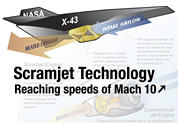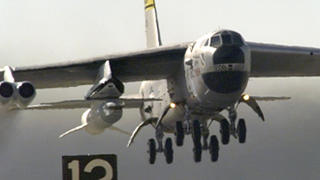Stratofortress II.

This is coolbert:
Stratofortress II.
It must not be forgotten that the B-52 has also played an important role in space exploration.
NOT traveling into space as would a rocket, but again, as in the modern role of the B-52, as a delivery vehicle.
Acts as a transport.
Carrying a rocket plane or guided missile to about 40,000 feet and dropping the space craft for engine ignition. By doing so, the B-52 allows the space vehicle to circumvent about 90 % of the earth's atmosphere.
[the amount of engine thrust to achieve space flight is much lessened by such a method. This was realized since the very advent of space exploration. All that friction presented to a rocket by the earth's atmosphere is overcome by using the B-52 as a transport!!]
Two B-52's, B Versions of the bomber, were tasked in the 1950's with providing support for NASA [National Aeronautics and Space Administration]. The most venerable of these bombers was number #008. Acted in the role of transport craft for a period of about fifty years!! Was outfitted with all the accoutrements to accomplish the task [special pylons, telemetry equipment, etc.]. And performed the task of transport vehicle without a hitch!
Remarkable. This aircraft has now been replaced by a civilian transport aircraft and will become a museum piece. The last of a dying breed!!
"B-52B 'Mothership' Launch Aircraft
NASA's venerable B-52B launch aircraft, operated by the NASA Dryden Flight Research Center, has participated in some of the most significant projects in aerospace history. At retirement, the air launch and research aircraft held the distinction of being NASA's oldest aircraft, as well as being the oldest B-52 on flying status. At the same time, it had the lowest number of flying hours (2443.8) of any B-52 in operation, having been used exclusively in the role it continued to perform so reliably for nearly 50 years.
The B-52B, registration number 52-0008 (NASA tail number 008), rolled out of Boeing's Seattle plant as an RB-52B, and first flew on June 11, 1955. The aircraft was the 10th B-52 to come off the Boeing assembly line and was a U.S. Air Force test aircraft before it was assigned to support the X-15 research aircraft program at Dryden in 1959."
"The other B-52 used in the X-15 program, tail number 003, was retired in 1969 and is on permanent display at the Pima County Air Museum in Tucson, Ariz."
Among the many missions and projects #008 was involved in were:
"X-15 Program
NASA 008 was one of two B-52s used as "motherships" to air-launch the three rocket-powered X-15 aircraft for research flights."

"The Lifting Bodies
Between 1966 and 1975, B-52 008 was the launch aircraft for 127 of the 144 flights of wingless lifting body aircraft that contributed to development of the Space Shuttle."
"Lifting bodies obtain aerodynamic lift from the shape of their bodies. The addition of fins and control surfaces allowed research pilots to stabilize and control the vehicles and maintain a predetermined flight path. Research flights with the vehicles proved that vehicles entering the atmosphere from space could be maneuvered to a safe runway landing - paving the way for full development of the space shuttle."

"Space Shuttle Program Support
In 1977 and l978, and again in the 1983-1985 time period, 008 was used as the launch aircraft in the test and development of the parachute recovery system used to recover the Space Shuttle's solid rocket boosters."
"From July to October of l990, the veteran B-52B was used for a series of eight tests of a drag chute deployment system to be installed on Space Shuttle orbiters.
The drag chutes permit the orbiters to land safely in a shorter distance and also help reduce tire and brake wear. The test unit, consisting of the test drag chute and its attachment and deployment systems, was installed in the tail of NASA 008, along with instrumentation to record loads and pressures on the deployed parachute and on the structure of the aircraft.
Tests were carried out at landing speeds ranging from 160 to 230 mph on a lakebed runway and also on the main concrete runway at Edwards. They demonstrated the initiation, deployment, inflation, and overall operation of the orbiter drag chute system. Data from the tests were used to validate predicted loads.
First operational use of the drag chute system was on Shuttle Endeavour, newest of the Space Shuttle fleet, during its first landing, May 16, 1992."

"NASA 008 was used as the air launch platform for the first six commercially developed Pegasus rocket boosters."
"Privately-funded, air-launched winged light satellite launcher. 4 stage vehicle consisting of 1 x NB-52 + 1 x Orion 50S + 1 x Orion 50 + 1 x Orion 38....more."

"The first of four lengthy series of test flights began in 1979 for a U. S. Air Force project to certify an extension of the operational life of the parachute recovery system on the F-111 crew escape module."
"Miscellaneous Support
NASA 008 was the launch aircraft for several remotely piloted aircraft flown by Dryden in the 1970s and l980s to study spin-stall, high angle of attack, and maneuvering characteristics."
"Hyper-X
In its final role in aerospace history, NASA 008 served as the launch aircraft for NASA's Hyper-X program."

Read further about the Hyper-X program by clicking here.

B-52B #008 had an enviable history of successful flight and support of research that was instrumental in the efforts of NASA for DECADES!!
coolbert.

0 Comments:
Post a Comment
Subscribe to Post Comments [Atom]
<< Home